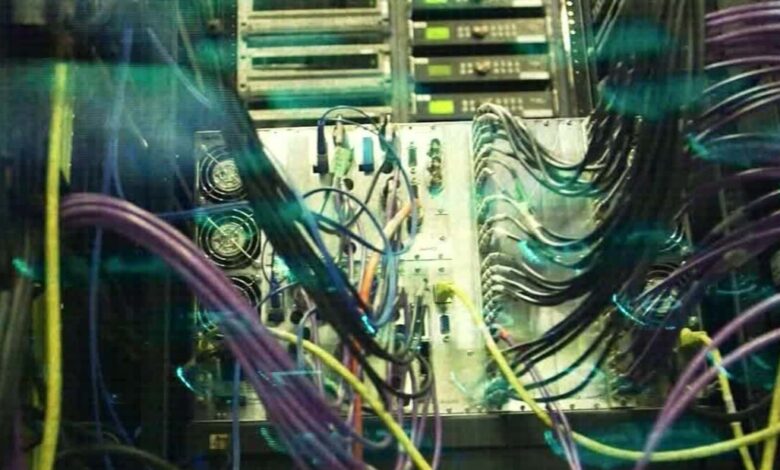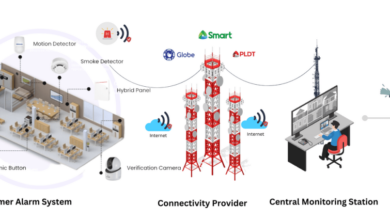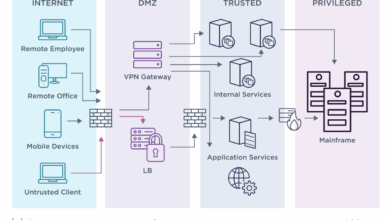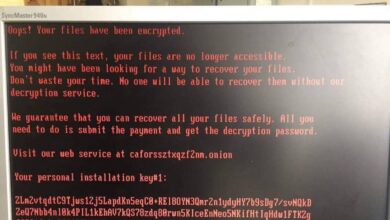
FBI Director Names Russia, China Top Cyber Threats
FBI Director terms Russia and China as biggest cyber threats to the United States – a statement that sent shockwaves through the cybersecurity world. This isn’t just another headline; it’s a stark warning about the escalating digital warfare between global powers. We’re talking about sophisticated attacks targeting critical infrastructure, sensitive data, and even our democratic processes. The implications are vast, reaching far beyond the tech sector and impacting our national security and everyday lives.
The FBI Director’s statement highlights a chilling reality: the digital battlefield is just as, if not more, dangerous than any physical one. This isn’t about a few rogue hackers; we’re talking about state-sponsored cyber armies with immense resources and expertise. Understanding the nature of these threats, the tactics employed by Russia and China, and the vulnerabilities of the US is crucial to navigating this increasingly perilous landscape.
FBI Director’s Statement on Russia and China as Cyber Threats
The recent statement by the FBI Director identifying Russia and China as the biggest cyber threats to the United States carries significant weight, given the FBI’s role in national security and its access to intelligence. This declaration isn’t simply a matter of assigning blame; it reflects a complex geopolitical landscape and has far-reaching implications for US foreign policy and cybersecurity strategies.The geopolitical context is one of escalating great power competition.
The US and China are locked in a strategic rivalry across multiple domains, from trade and technology to military power and influence. Similarly, relations with Russia remain strained, particularly in the wake of the ongoing war in Ukraine and persistent allegations of Russian interference in US elections. This backdrop of intense competition fuels a cyber arms race, where states utilize digital tools to achieve strategic advantages, often blurring the lines between espionage, sabotage, and outright warfare.
Geopolitical Implications of the FBI Director’s Statement
The FBI Director’s statement underscores the gravity of the cyber threat and could influence several aspects of US foreign policy. It might lead to increased pressure on both Russia and China through diplomatic channels, sanctions, or other forms of countermeasures. It also strengthens the argument for increased investment in national cybersecurity infrastructure and the development of more robust defensive capabilities.
Furthermore, the statement could galvanize international cooperation to address the global challenge of state-sponsored cyberattacks, potentially leading to new treaties or agreements to establish norms of behavior in cyberspace. The statement also serves as a warning to both countries, signaling a heightened level of US awareness and preparedness to counter their cyber operations.
Examples of Previous Cyberattacks Attributed to Russia and China
Russia and China have long been implicated in various cyberattacks. For example, Russia has been linked to the NotPetya ransomware attack in 2017, which caused billions of dollars in damage globally, and to the SolarWinds supply chain attack, which compromised numerous US government agencies and private companies. These attacks demonstrated Russia’s capability to conduct sophisticated, large-scale operations designed to disrupt critical infrastructure and steal sensitive information.
China, on the other hand, has been accused of extensive intellectual property theft targeting US businesses and universities, often employing state-sponsored hacking groups to infiltrate networks and steal valuable data. The scale and sophistication of these operations underscore the need for a robust national cybersecurity response.
Types of Cyberattacks Attributed to Russia and China
The types of cyberattacks attributed to Russia and China vary widely, reflecting their different strategic goals and capabilities. Russia’s attacks often involve disruptive malware, designed to cripple critical infrastructure or disrupt essential services. They also engage in espionage operations, targeting government agencies and private companies to steal sensitive information. China’s cyber operations frequently focus on intellectual property theft, targeting industries like technology, pharmaceuticals, and finance to gain economic advantage.
Both countries also utilize disinformation campaigns and influence operations to sow discord and manipulate public opinion. These operations highlight the multifaceted nature of the cyber threat and the need for a comprehensive approach to national cybersecurity.
Russia’s Cyber Capabilities and Tactics
Russia possesses sophisticated cyber warfare capabilities, posing a significant threat to the United States and other nations. These capabilities are not solely the domain of a single entity but rather a complex network involving state-sponsored groups, private contractors, and even loosely affiliated criminal actors, all operating with varying degrees of government oversight and direction. Understanding the structure and methods of these operations is crucial to mitigating the risks they pose.
Structure and Capabilities of Russian Cyber Warfare Units
Russia’s cyber warfare capabilities are distributed across various entities, making attribution difficult. The GRU (Main Intelligence Directorate), FSB (Federal Security Service), and SVR (Foreign Intelligence Service) are all believed to possess significant cyber units. These units employ highly skilled personnel with expertise in malware development, network penetration, data exfiltration, and disinformation campaigns. Their capabilities extend to targeting critical infrastructure, financial institutions, and political organizations, demonstrating a wide range of operational objectives.
The organizational structure within these units is often compartmentalized, limiting the impact of any single compromise and allowing for deniability.
Methods of Cyber Espionage and Sabotage
Russia’s favored methods of cyber espionage involve sophisticated malware, spear-phishing campaigns, and exploitation of vulnerabilities in software and hardware. These techniques allow them to gain unauthorized access to computer systems and networks, stealing sensitive information, intellectual property, and military secrets. Sabotage tactics often involve disruptive attacks, aiming to disable or damage critical infrastructure, disrupting essential services, and causing economic or political instability.
The NotPetya malware, for example, while initially attributed to a state-sponsored actor with ties to Russia, caused billions of dollars in damages worldwide, showcasing the destructive potential of these operations.
Comparison with Other Nation-State Cyber Tactics
While other nation-states also employ cyber warfare, Russia’s tactics often stand out for their scale, sophistication, and willingness to engage in disruptive and destructive attacks. Compared to China, which often focuses on economic espionage and intellectual property theft, Russia demonstrates a broader range of targets and objectives, including political influence operations and disruption of critical infrastructure. While both China and Russia utilize advanced malware, Russia’s operations sometimes display a higher degree of recklessness, potentially reflecting a greater willingness to accept collateral damage.
The tactics employed by other actors, such as North Korea (focused on financial theft), differ significantly in their motives and scale of operations.
Examples of Russian Cyberattacks
| Attack Name | Target | Method | Outcome |
|---|---|---|---|
| NotPetya | Global Businesses and Infrastructure | Widespread Malware | Billions in damages worldwide |
| Colonial Pipeline Attack | US Fuel Pipeline | Ransomware | Disruption of fuel supply |
| SolarWinds Attack | US Government Agencies and Private Companies | Supply Chain Compromise | Data breaches and espionage |
| 2016 US Election Interference | US Election Infrastructure | Disinformation and Hacking | Undermining public trust and democratic processes |
China’s Cyber Capabilities and Tactics

China’s cyber capabilities are extensive and sophisticated, posing a significant threat to the United States. Unlike Russia’s more overtly disruptive and politically motivated cyber operations, China’s strategies are often more focused on long-term economic gain and intellectual property theft, though political motivations are certainly present. This nuanced approach requires a different understanding of their tactics and motivations.
State-Sponsored Hacking in China’s Cyber Operations, Fbi director terms russia and china as biggest cyber threats to the united states
The Chinese government plays a significant, albeit often clandestine, role in its cyber operations. State-sponsored hacking groups, often linked to the People’s Liberation Army (PLA) or other government agencies, are responsible for a significant portion of China’s cyber espionage and theft. These groups often operate with advanced skills and resources, making them exceptionally difficult to detect and counter. Their actions are frequently shrouded in secrecy, making attribution challenging, but circumstantial evidence and investigative reports consistently link them to the Chinese government.
The level of coordination and resources involved strongly suggests state sponsorship and approval.
Economic Motivations Behind China’s Cyber Activity
China’s cyber activities are largely driven by economic motivations. The theft of intellectual property, trade secrets, and sensitive business information is a primary focus. This pursuit of economic advantage allows China to rapidly advance its technological capabilities, gain a competitive edge in global markets, and reduce its reliance on foreign technology. This strategy is not limited to private sector targets; critical infrastructure information is also a prime target to gain leverage and potential control.
The goal is not simply disruption, but long-term strategic economic advantage.
Examples of Chinese Cyberattacks Targeting US Infrastructure and Businesses
The scale and scope of Chinese cyberattacks against the US are substantial. While precise details are often kept confidential for national security reasons, several well-documented cases highlight the threat.
- The theft of intellectual property from US companies: Numerous US companies across various sectors, including technology, pharmaceuticals, and manufacturing, have been victims of sophisticated cyber espionage operations attributed to Chinese state-sponsored actors. These attacks often involve the infiltration of corporate networks to steal sensitive data, designs, and trade secrets.
- Attacks on US critical infrastructure: While less publicized than attacks on private businesses, there’s evidence suggesting attempts to compromise critical infrastructure, including energy grids and financial institutions. The aim is not necessarily immediate disruption but rather to gain access and establish a foothold for future exploitation. This is a long game for potential strategic advantage.
- Targeting of government agencies: Chinese cyber actors have also targeted US government agencies, aiming to steal classified information and intelligence. These attacks are typically highly sophisticated and require advanced technical skills to bypass security measures.
US Vulnerability to Cyberattacks
The United States, with its sprawling and interconnected infrastructure, faces significant vulnerabilities to cyberattacks. Our reliance on digital systems across every sector of society, from finance to healthcare to energy, creates a vast attack surface for malicious actors. A successful cyberattack against critical infrastructure could have devastating consequences, impacting not only the economy but also national security and public safety.The interconnected nature of our systems means that a breach in one area can quickly cascade, causing widespread disruption.
This interconnectedness, while beneficial in many ways, also acts as a multiplier for the impact of cyberattacks. A successful attack on a single component can quickly compromise the entire system.
Critical Infrastructure Sectors Most Vulnerable to Cyberattacks
Several critical infrastructure sectors are particularly vulnerable due to their reliance on aging technology, limited cybersecurity budgets, and the sheer scale of their operations. These include the energy sector (power grids, pipelines), financial institutions, healthcare systems (hospitals, medical devices), and transportation networks (air traffic control, rail systems). Attacks on these sectors could lead to widespread power outages, financial instability, disruptions to healthcare services, and significant transportation delays.
Potential Consequences of Successful Cyberattacks on Critical Infrastructure Sectors
The consequences of successful cyberattacks on these sectors are far-reaching and potentially catastrophic. A large-scale cyberattack on the power grid could cause widespread blackouts, crippling essential services and impacting millions of people. Disruption to financial institutions could trigger economic instability, impacting global markets. Compromised healthcare systems could lead to data breaches, disruptions to patient care, and even loss of life.
Transportation network disruptions could cause significant delays and logistical nightmares, impacting both commerce and the daily lives of citizens.
The FBI director’s warning about Russia and China as major cyber threats to the US hits close to home when you consider the recent news; it’s unsettling to learn that Facebook is apparently asking for bank account info and card transactions of users, as detailed in this article facebook asking bank account info and card transactions of users.
This kind of data breach makes you wonder if these foreign actors are exploiting vulnerabilities like this to further their cyber warfare, highlighting the FBI director’s concerns even more.
Hypothetical Scenario: Coordinated Cyberattack from Russia and China
Imagine a coordinated cyberattack launched by Russia and China targeting multiple critical infrastructure sectors simultaneously. Russian actors might focus on disrupting the energy grid, employing sophisticated malware to disable power plants and substations, while Chinese actors concentrate on infiltrating financial institutions, stealing sensitive data and manipulating market activity. This coordinated attack could trigger a cascading effect, causing widespread power outages, financial market chaos, and disruption to essential services, leading to widespread panic and potentially even civil unrest.
The attack would be difficult to attribute definitively, given the potential for each nation to utilize proxy servers and other obfuscation techniques. The recovery process would be lengthy and expensive, requiring significant investment in cybersecurity infrastructure and expertise.
Preventative Measures to Mitigate Cyber Threats
The US needs a multi-pronged approach to mitigate cyber threats. This requires a combination of proactive measures and robust response capabilities.
The FBI director’s warning about Russia and China’s cyberattacks highlights a critical need for robust security measures. Strengthening our defenses requires a proactive approach, and that’s where solutions like those discussed in this article on bitglass and the rise of cloud security posture management become essential. Ultimately, improving our cloud security posture is crucial in mitigating the risks posed by these major cyber threats from Russia and China.
- Increased investment in cybersecurity infrastructure: Modernizing aging systems and implementing robust security protocols across all critical infrastructure sectors is paramount.
- Improved information sharing and collaboration: Enhanced collaboration between government agencies, private sector companies, and international partners is crucial for sharing threat intelligence and coordinating responses.
- Strengthening cybersecurity workforce: Investing in training and education to develop a skilled cybersecurity workforce is essential to effectively defend against sophisticated cyberattacks.
- Development of advanced cyber defense technologies: Continuous investment in research and development of new technologies to detect and prevent cyberattacks is crucial.
- Enhancing international cooperation: Working with allies to develop international norms and standards for responsible state behavior in cyberspace is necessary to deter malicious actors.
- Strengthening legal frameworks: Developing and enforcing strong legal frameworks to deter and prosecute cybercriminals is essential.
- Public awareness campaigns: Educating the public about cybersecurity threats and best practices can help prevent individual vulnerabilities from being exploited.
International Cooperation and Response

International cooperation in combating cybercrime is crucial, yet incredibly challenging. The decentralized and borderless nature of cyberspace makes it difficult to establish clear jurisdictional boundaries and coordinate effective responses across nations with varying legal frameworks and priorities. Furthermore, the sophistication of cyberattacks and the diverse range of actors involved, from state-sponsored groups to individual hackers, adds significant complexity.The challenges of international cooperation stem from several key factors.
Different countries have varying levels of cybersecurity capabilities and resources, leading to disparities in their ability to detect, investigate, and prosecute cybercrimes. Differing legal systems and interpretations of international law create obstacles to evidence sharing and mutual legal assistance. Furthermore, political tensions and mistrust between nations can hinder collaboration, especially in cases where state-sponsored cyberattacks are suspected.
Successful International Collaborations in Cybersecurity
Several successful examples demonstrate the potential of international cooperation. The Budapest Convention on Cybercrime, for instance, provides a framework for international cooperation in investigating and prosecuting cybercrimes. This treaty facilitates the exchange of information and evidence across borders, offering a legal basis for joint investigations and prosecutions. Additionally, various bilateral and multilateral agreements exist between countries, focusing on specific cybersecurity threats or areas of collaboration.
The FBI director’s warning about Russia and China’s escalating cyberattacks on the US is seriously concerning. We need robust, secure systems, and that’s where the advancements in application development come in; check out this article on domino app dev the low code and pro code future for insights into building more resilient applications. Ultimately, strengthening our digital infrastructure is crucial in mitigating the threats posed by these nations.
For example, information-sharing agreements between intelligence agencies and law enforcement bodies help track down perpetrators and prevent future attacks. Joint cybersecurity exercises and training programs also enhance international collaboration by fostering communication and building trust among participating nations. These collaborations often lead to the identification and disruption of significant cybercriminal networks.
The Role of International Law and Treaties in Addressing Cyber Threats
International law plays a vital role in establishing norms of behavior in cyberspace and providing a legal basis for international cooperation. While a comprehensive international cybercrime treaty remains elusive, existing legal instruments, such as the Budapest Convention, provide a foundation for addressing certain aspects of cybercrime. Furthermore, international humanitarian law and human rights law apply to cyber operations, setting limits on the use of cyber weapons and protecting civilian populations from cyberattacks.
The development and adoption of new international norms and treaties are crucial for establishing clear rules of engagement in cyberspace and for strengthening international cooperation in combating cybercrime. The ongoing efforts to develop a legally binding instrument on responsible state behavior in cyberspace reflect this need.
Visual Representation of International Cybersecurity Cooperation Complexities
Imagine a complex web, where each node represents a country. The nodes are connected by various lines, representing different forms of cooperation: thick lines for strong, established partnerships; thin lines for less formalized collaborations; dotted lines for tenuous or broken connections. Some nodes are brightly lit, representing countries with advanced cybersecurity capabilities, while others are dimmer, indicating a lack of resources or expertise.
Arrows on the lines indicate the direction of information sharing or assistance. The web is constantly shifting, with lines forming and breaking, reflecting the dynamic nature of international relations and the ever-evolving cyber threat landscape. Overlapping circles within the web represent international organizations and treaties that attempt to create order and structure within this chaotic system. The overall image highlights the interconnectedness and the inherent challenges of coordinating efforts across numerous nations with varying capabilities, interests, and levels of trust.
The Role of Private Sector in Cybersecurity

The private sector plays a crucial, and arguably the most significant, role in defending against cyberattacks. While government agencies like the FBI provide crucial intelligence and frameworks, it’s private companies that own and operate the vast majority of critical infrastructure and data. Their responsibility, therefore, extends to proactively securing their own systems and contributing to the overall national cybersecurity posture.Private companies have a multifaceted responsibility in protecting against cyberattacks.
This includes implementing robust security measures, such as firewalls, intrusion detection systems, and regular security audits. Beyond technical measures, companies must also prioritize employee training and awareness programs to combat phishing scams and social engineering attacks, which often serve as the initial vector for successful breaches. Furthermore, a commitment to incident response planning is vital, ensuring a swift and effective reaction to any successful attacks, minimizing damage and facilitating recovery.
This includes establishing clear communication protocols and working closely with law enforcement and cybersecurity firms when necessary.
Responsibilities of Private Companies in Cybersecurity
Private companies bear the primary responsibility for the security of their own systems and data. This involves a comprehensive approach encompassing technical safeguards, employee training, incident response planning, and regular security assessments. Failure to adequately protect systems can lead to significant financial losses, reputational damage, and legal repercussions. For example, a data breach resulting in the exposure of customer information can lead to substantial fines under regulations like GDPR or CCPA, as well as loss of customer trust and market share.
The Role of Cybersecurity Firms in Defense Against Threats
Cybersecurity firms offer a wide range of services to help organizations defend against cyber threats. These services can include vulnerability assessments, penetration testing, incident response, security awareness training, and the implementation and management of security information and event management (SIEM) systems. These firms employ specialized experts who stay abreast of the latest threats and vulnerabilities, providing a crucial layer of expertise that many organizations lack internally.
Larger companies often maintain internal security teams, but even these teams frequently utilize the services of external firms for specialized tasks or to provide a second opinion on their security posture.
Comparing and Contrasting Approaches of Different Cybersecurity Companies
Different cybersecurity companies specialize in different areas and offer varying approaches. Some focus on providing comprehensive managed security services, handling all aspects of an organization’s cybersecurity needs. Others specialize in specific areas, such as incident response, penetration testing, or cloud security. For instance, some firms might excel in detecting and responding to advanced persistent threats (APTs), while others focus on protecting against ransomware attacks.
The approach also varies in terms of pricing models; some offer fixed-fee contracts, while others charge based on the scope and complexity of the work. The choice of cybersecurity firm should be based on an organization’s specific needs and budget.
Examples of Successful Private Sector Responses to Major Cyberattacks
Several companies have demonstrated successful responses to major cyberattacks. For example, Target’s response to the 2013 data breach, while initially criticized, ultimately involved significant investment in enhancing its security infrastructure and improving its incident response capabilities. Similarly, companies like Equifax, despite initial missteps, have implemented significant changes to their security practices following major data breaches. These examples, while highlighting the severity of the consequences of cyberattacks, also showcase the ability of private companies to learn from their experiences and improve their security postures over time.
Successful responses often involve swift containment of the attack, thorough investigation to understand the root cause, and proactive communication with affected parties and regulators.
Conclusive Thoughts: Fbi Director Terms Russia And China As Biggest Cyber Threats To The United States
The FBI Director’s declaration isn’t just a call to arms; it’s a wake-up call. The threat from Russia and China is real, persistent, and sophisticated. While the challenges of international cooperation are significant, a multi-pronged approach involving governments, private sector companies, and individuals is essential to bolster our defenses. We need to strengthen our cyber infrastructure, improve intelligence sharing, and cultivate a culture of proactive cybersecurity awareness.
The digital fight for our future is on, and we need to be ready.
Essential FAQs
What specific types of cyberattacks are Russia and China accused of?
Both nations are accused of a wide range of attacks, including espionage, data theft, infrastructure sabotage, and disinformation campaigns. Specific examples include targeting critical infrastructure like power grids and election systems.
How can individuals protect themselves from these cyber threats?
Individuals can protect themselves by practicing strong password hygiene, being wary of phishing scams, keeping software updated, and using reputable antivirus software. Education and awareness are key.
What role does international law play in addressing state-sponsored cyberattacks?
International law is still evolving in this area. There’s a lack of clear consensus on attribution and appropriate responses to state-sponsored cyberattacks, making international cooperation challenging.





